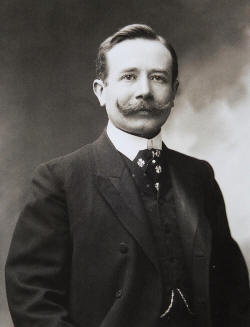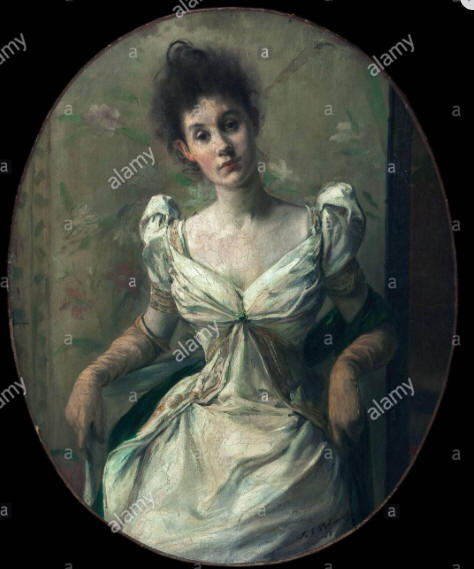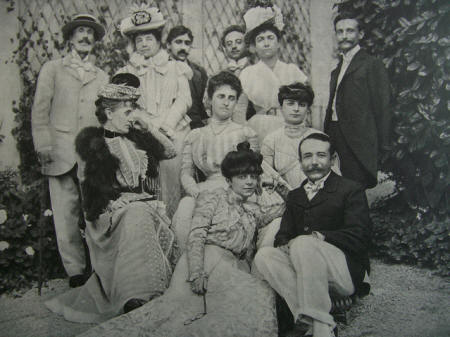

Queer Places:
27 Rue du Faubourg Saint-Honoré, 75008 Paris, France
 Abel Hermant (3 February 1862 – 29 September 1950) was a French novelist, playwright, essayist and writer, and member of the Académie française.
Abel Hermant (3 February 1862 – 29 September 1950) was a French novelist, playwright, essayist and writer, and member of the Académie française.
Hermant was born in Paris, the son of an architect. He received a degree from the École Normale Supérieure in 1880, and published his first volume of verse in 1883, The Contempt. After several youthful novels, he moved to ironic analysis of the popular mores of the Belle Époque and achieved popular success. His first semi-autobiographical novel, Monsieur Rabosson of 1884, established his reputation as a satirical social observer. Its follow-up Le Cavalier Miserey of 1887, dealt with the issue of homosexuals in the military. Between 1901 and 1937 Hermant embarked on a series of 20 linked novels with the general title Memoirs to Serve for a History of Society, but his contributions to literature included many popular plays, drama criticism for Le Figaro and Gil Blas, and a series of grammarian articles for Le Temps under the name "Lancelot" defending the purity of the French language. By 1899 Hermant was well-connected in society; for instance he was the guest of Anna de Noailles at Évian-les-Bains, where he became friends with Marcel Proust.
Invited to Champrosay by Alphonse Daudet, he met among others the brothers Goncourt, Émile Zola and Joris-Karl Huysmans. He frequented the famous "Grenier" of the Goncourts, was received by Émile Zola in Médan and was prominently included among the guests of Madame Charpentier's salon, wife of the publisher Georges Charpentier where he met his future wife, Georgette Charpentier, who appears in the painting by Renoir Mrs. Georges Charpentier and her children. Leon Daudet, who met Abel Hermant at his father's house, made the future French academician his head of Turk: it is to him that we owe the nicknames of "Bebel", "Coin-coin", "The Duck of Vaucansson", "La Belle Hermant". This last nickname was transformed for one of the friends often crossed in the Parisian salons alongside Abel Hermant, Constantine Bibesco-Bassaraba de Brancovan, who was nicknamed "Beauty on the arm of Hermant".

Madame Abel Hermant by Jacques-Emile Blanche

From left to right, standing: Prince Edmond de Polignac, Princess of Brancovan (Rakoul
(Rachel) Musurus), Marcel Proust, Prince Constantin Brancoveanu (brother of Anna de Noailles), and Léon Delafosse. 2nd row: Madame de Montgenard, Princesse de Polignac, Countess Anna de Noailles, 1st row: Princess Helen Caraman-Chimay (sister of Anna de Noailles), Abel Hermant
As a young man, Abel became friends with a young American born in Nice, George Hall, who lived in boarding school, in 1879, in Lausanne. Abel was twenty, and George was 19. Their friendship survived a decade after George Hall left for California. Abel Hermant's letters to George Hall, kept in the Yale University Library, recount all these adventures experienced by the young writer.
Cavalier Miserey (1887) achieved scandal success and truly launched Abel Hermant. The novel, based on the author's experience of military service in 1884 at the 12th Regiment of Horse Hunters in Rouen, tells the story of a young engaged (Miserey), from a simple background, the son of a father who was once a military and ended up a second lieutenant in this regiment. A captain of this regiment burned the book on a pile of manure and Abel Hermant was provoked into a duel. The intervention of his friends at the Grenier des Goncourt put an end to what could have been an endless succession of duels. Hermant still found defenders, including a captain who would become marshal of France and who would help his entry into the French Academy: Hubert Lyautey.
After an engagement celebrated on 4 September in the carpenter's second home called the Paradou, in Royan (Charente-Maritime), on November 26, 1888, he married the daughter of the publisher Georges Charpentier, Georgette Charpentier (1872-1945), then 16 years old. The witnesses to the religious wedding celebrated in the Church of St. Thomas Aquinas were Alphonse Daudet, Edmond de Goncourt, Émile Zola and Theodore de Banville. Jeanne Hugo made the quest during the ceremony. The couple divorced in 1892, two years after death, at the age of 28 days, on January 20, 1890, of their only son, Marcel Jean-Georges Abel Hermant. This dramatic death encouraged Ms. Charpentier to found Porchefontaine's Nursery, with the aim of combating infant mortality.
Abel Hermant's reputation for homosexuality grew in Parisian salons. It is attested by the testimonies of his contemporaries as well as by his work itself. This reputation, in the sulphurous era, tainted Abel Hermant's assumption of a natural son of Mathilde Ardavani, named Joachim Marcel, who was born in Paris on 22 April 1888: Hermant's adoption is suspected of being motivated by sentimental inclinations for the teenager. However, the adoption was officially pronounced on 11 October 1915. Joachim, then 27 years old, used the name Marcel Abel Hermant instead of the official name of Joachim Marcel Ardavani-Hermant.
After a number of tries Hermant was elected to the Académie française on 30 June 1927. During World War II Hermant's contributions to Jean Luchaire's pro-Nazi evening daily newspaper Les Nouveaux Temps, beginning in 1940, his open support of the Vichy regime, and his criticisms of the French Army, marked him as a collaborator. At over 80 years of age, he was sentenced to life in prison on 15 December 1945. Hermant achieved the negative distinction of being one of the four "immortals" removed from the Académie française after World War II for collaboration with Germany. Hermant and Abel Bonnard were expelled outright, in disgrace; Charles Maurras of Action Française and Marshal Philippe Pétain had their seats declared vacant and were not replaced until their deaths. Pardoned and released in 1948, Abel Hermant tried to justify his conduct during the Occupation in his Thirteenth Notebook. He died shortly thereafter.
My published books: